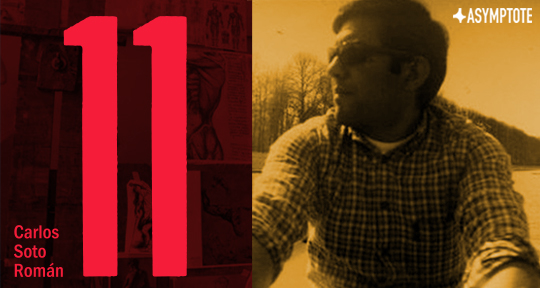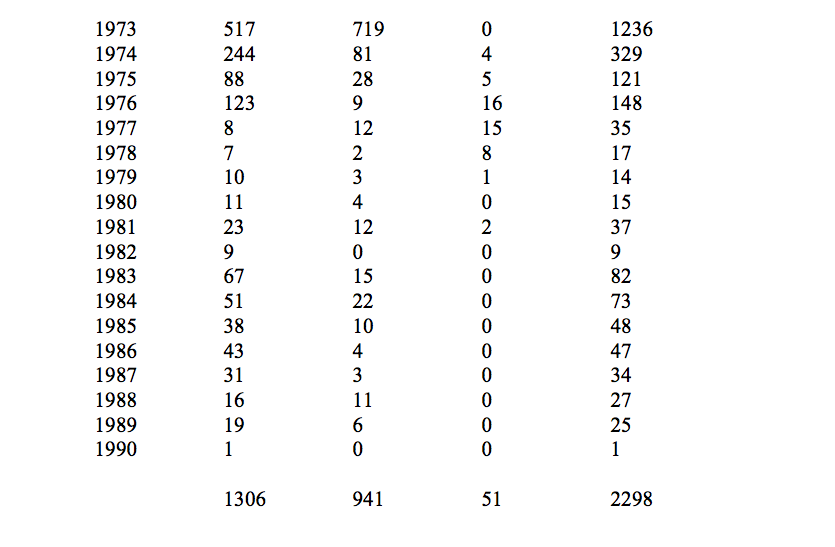September 11, for many around the world today, is a date that is filled with images of the horrifying attack on the Twin Towers in 2001. However, in the shadow of that attack is another September 11, one that took place nearly thirty years before the tragedy in America. The murder of Chilean President Salvador Allende on September 11, 1973, marks the establishment of a brutal dictatorship in Chile. It is this date, as well as the latter September 11, that Carlos Soto Román contends with in his book 11. Erasure, algorithmic manipulation, and blank spaces take center stage in this evocative text, as Asymptote‘s Scott Weintraub discovers.
In his book-object 11—the winner of the 2018 Santiago Municipal Poetry Prize—Soto Román develops a material(ist) poetics steeped in absence, nothingness, the palimpsest, censorship, and the erased or altered quotation. He elaborates a profound politics of conceptualism in which no word or line is, strictly speaking, “by” the author himself. Soto Román’s writing, therefore, draws him near to certain North American poets associated with conceptualism in one way or another, such as Kenneth Goldsmith or Vanessa Place; his deep engagement with the ludic and the via negativa, however, allows one to associate him with the visual experiments of Vicente Huidobro (1893-1948), the carefully cultivated disappearance of the author practiced by Juan Luis Martínez (1942-1993), and the deconstruction of institutionalized discourses employed by Rodrigo Lira (1949-1981).
September 11, 1973, marks the greatest crisis that the Chilean democratic tradition has ever faced. On this date, General Augusto Pinochet carried out a (U.S.-supported) coup d’état in which democratically-elected Socialist President Salvador Allende was brutally murdered; it was the start of seventeen years of dictatorship during which numerous instantiations of unthinkable violence took place, including murder, political assassination, desapariciones [disappearances], violations of human rights, and forced exile, for example. On the cover of Soto Román’s 11, the reader finds the infamous date of September 11 doubly inscribed: the gray image of the number one (repeated or doubled) recalls both the Chilean coup that installed General Pinochet as dictator as well as the attack on the Twin Towers in New York in 2001:
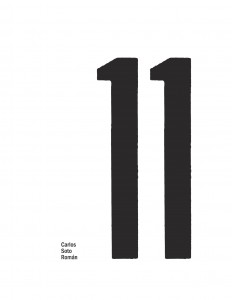
This visual citation of the New York City skyline contrasts with the black, coffin-like enclosure that “buries” the texts contained within the book-object in a funerary gesture that evokes two works by Juan Luis Martínez: Chilean Poetry (1978) and The Anonymous Poet (or Juan Luis Martínez’s Eternal Present) (2013). Soto Román also evokes the cover of Martínez’s masterpiece The New Novel (1977): in The New Novel, the reader witnesses the disaster represented in the cover photo of homes destroyed by an earthquake, whereas in 11 the disaster of the coup is unnatural, man-made.
As a whole, in 11, Soto Román carefully places official documents relating to Pinochet’s dictatorship on the frontier of legibility through several material operations. To name a few, the poet erases (con)texts, removes vowels from names, suppresses photographs described in the text that accompanies them, rearranges official reports into “verses,” plays with blank space and enjambment, etc. This discursive violence against the official nature of texts goes beyond what critic Marjorie Perloff describes in her book Unoriginal Genius: Poetry by Other Means in the New Century (2010), where she argues that a large part of contemporary (and historical) writing involves a poetics or an ethics of appropriation without citation. Soto Román’s work goes even further, operating as an interface in its assembly and rearranging of information by way of myriad constraints or algorithms. In the interface “programmed” by Soto Román, the violence of the coup and the dictator’s neoliberal machine involves or implies (bearing witness to) the creation of a machine designed to produce depersonalized and dehumanized oppression, which might then be instituted in new contexts of violence and repression.
In 11, Carlos Soto Román tells the story of the military regime in chronological order—but in a deliberately partial and censored way, using the tactic of censorship as a strategy of resistance. The reader of 11 finds that many details and pieces of information have already been removed from forms or victims’ testimonies, showing the depersonalization and institutionalization of repression. For example, after registering specific details about torture sessions—including the areas of the body to which electric shock has been applied and the tools employed—Soto Román transcribes the partial testimony of a victim of torture, but leaves the final part of each sentence blank:
they disrobe me completely and tie me to ____________________.
they put a band around my head and throw water on ____________________.
below the band and at the level of my temples they fit me with ____________________.
and on my stomach another____________________.
they hit me with electric current.
they interrogate me about ____________________.
they tell me to raise a finger to stop the ____________________.
this session lasts between ____________________.
The play between presence and absence, between the information that is transmitted and that which is censored, traces a spectral cartography between disappearance and dehumanization. The violence done to this report (and multiplied in the non-attributed quote) mimes the violence inflicted upon the detained person’s body, thereby transforming the testimony into an exercise or task to be completed by the reader. This sort of macabre or perverse activity recalls the extensive ludic tradition of interactivity in Chilean literature; significant examples include Alejandro Zambra’s Multiple Choice (2014), Diamela Eltit’s E. Luminata (1983), and the aforementioned The New Novel (1977) by Juan Luis Martínez, among others.
11 makes use of a poetics of found lists and images to narrate the violent history of Pinochet’s regime: for example, Soto Román includes a technical diagram of a Puma helicopter alongside two lists of Chilean cities and towns:
| Rancagua
Curicó Talca Linares Concepción Temuco Valdivia Puerto Montt Cauquenes ____________ 26 |
La Serena
Copiapó Antofagasta Calama Iquique Pisagua Arica ____________ 71 |
The cartography outlined here reproduces the itinerary of two Puma helicopters that left Santiago—one headed north, one headed south—as part of what would become known as the “Caravan of Death,” which took place during September-October 1973 and killed 71 and 26 people, respectively. The proliferation of lists and decontextualized sums is especially prominent in the lists of charges, sentences, and diagnostics of Pinochet himself in the final pages of the book-object, alongside the compulsive repetition (twenty-seven times) of a phrase uttered in the British House of Lords: “Senator Pinochet is not immune.” As is the case in Chile Project: [Reclassified], in 11’s palimpsestic writing Soto Román erases, crosses out, and recodifies or re-cites preexisting texts and lists. In a text that appears to denounce an act of torture, for example, the entire text is actually erased, with the exception of the footnotes.
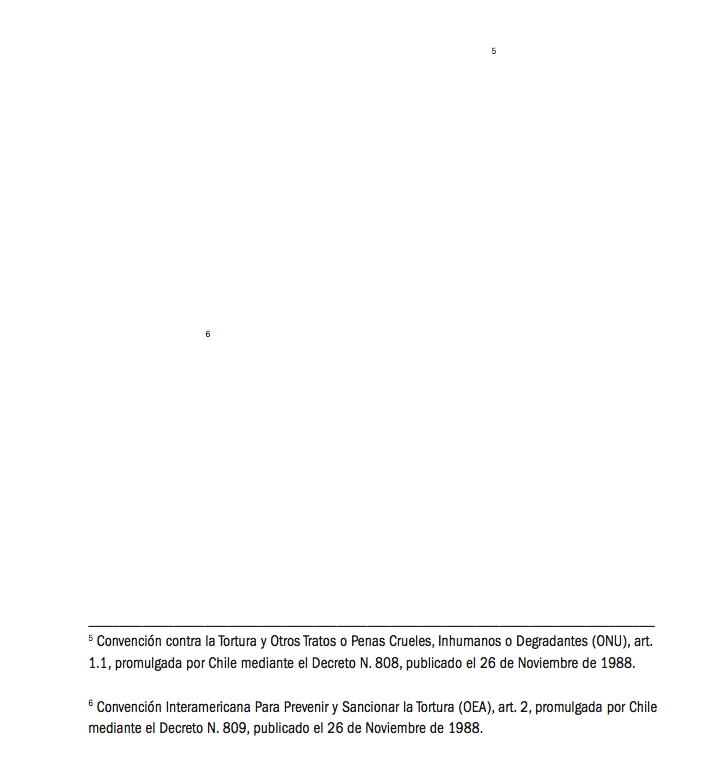
The legal references to cruel and unusual punishment and torture, put forward by the UN and OAS, suffer the same fate as other (unattributed) registers of the dead and the detained during the dictatorship. In a few pages censored by the writer himself—which stand out for their scarce, carefully altered content—Soto Román provides the following information:
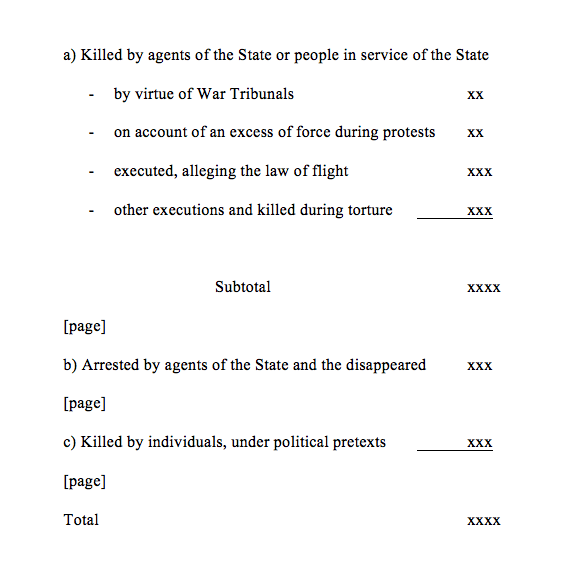
This is a re-classified fragment from the Rettig Report (The National Commission for Truth and Reconciliation Report, 1991): in the Commission’s report, the total represents “victims of violations of human rights”—excluding 164 “victims of political violence”—therefore yielding the sum of 2279 (“Informe Rettig” 1131). However, the crossed-out figures here contrast with the following presentation of decontextualized figures—organized by year, from 1973 to 1990—in which the information necessary to understand or interpret them is completely absent.
This table is untitled in 11 and “reveals” the “Place and date of death and of arrest of the detained-disappeared,” dividing these events into columns based on where they took place: the Santiago Metropolitan Area, other regions, or other countries (from left to right; “Informe Rettig” 1366). The performative act of erasing or suppressing this information before inserting the table into the book-object illuminates certain aspects of Craig Dworkin’s argument that “one does not need to generate new material to be a poet” (xliv). In 11, Soto Román reframes or reorganizes information and text in meaningful “détournements” of language vis-à-vis rules and constraints (xliv). In the book-object’s colophon, Soto Román reveals the source texts for this work of experimental writing:
The poems included in this work were crafted from audio and textual material, found in documentaries, interviews, articles, and a variety of types of other documents.
Amongst the sources I wish to highlight the following: Constitución Política de la República de Chile, Informe Rettig, Informe Valech, Manual KURBACK, newspapers and magazines from the era of the dictatorship, website of the project “Los Casos del los Archivos del Cardenal” from the UDP School of Journalism and CIPER, the digital archive of the Centro de Estudios Miguel Enríquez, archives of the Biblioteca Digital del Museo de la Memoria y los Derechos Humanos.
The gesture of appropriation in 11, then, is approximately the inverse (or at least is tangential to) what poet Carlos Cociña attempts in Plagiarism of Affect, in which footnotes at the bottom of each poem indicate where the appropriated material comes from, but without indicating what is being cited and what is “original.”
In 11, then, Soto Román uses appropriation in order to exaggerate or intensify censorship, in a negative poetics that in no way falls into the trap of nihilism or negativism itself. As I have shown in my analysis of some key moments from his brilliant book-object, the interface or conceptualist machine that he builds employs various tactics of resistance in order to make absences and silences speak. These tensions draw Soto Román close to the profound disappearance or erasure of the poetic voice in work by Juan Luis Martínez, who, in a poem titled “The Stamped Swan,” describes “the reality of the page as fiction of itself / the final canto of that sign on the back of the page / the back of its canto: the exhalation of its final poem” (The New Novel 87). In 11, the reality of the erased, crossed out, and the altered page is indeed the fiction of itself. We do not confront the end of poetry here (in spite of Rodrigo Lira’s assertion that “Poetry ended with me,”); however, the attentive reader of 11 does indeed witness an impressive, apocalyptic gesture, even within the storied tradition of experimental and radical Chilean poetry.
Carlos Soto Román (1977) is the author of Marcha de los Quiltros [March of the Mutts] (1999), Haikú Minero [Mining Haiku] (2007), Cambio y Fuera [Change and Get Out] (2009), and 11 (2017)—all published in Chile—, as well as Philadelphia’s Notebooks (Otoliths, 2011), Chile Project: [Re-Classified] (Gauss PDF, 2013), and Alternative Set of Procedures (Corollary Press, 2014), which were published in the United States. Trained as a pharmacist with a Master’s degree in Bioethics, Soto Román is a well-known translator and curates Elective Affinities, a prominent cooperative anthology of U.S. poetry.
Scott Weintraub (PhD Emory University, 2006) is an Associate Professor of Hispanic Studies at the University of New Hampshire. He is the author or co-editor of over ten books and special journal issues, including two books on experimental Chilean poet Juan Luis Martínez and Latin American Technopoetics: Scientific Explorations in New Media (Routledge, 2018).
*****
Read more essays on the Asymptote blog:

